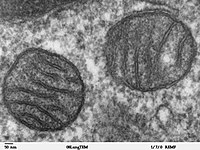
Photo from wikipedia
Significance The mitochondria, organelles that produce the largest amounts of ATP and reactive oxygen species (mROS) in living cells, are equipped with a universal mechanism that can completely prevent mROS… Click to show full abstract
Significance The mitochondria, organelles that produce the largest amounts of ATP and reactive oxygen species (mROS) in living cells, are equipped with a universal mechanism that can completely prevent mROS production. This mechanism consists of mild depolarization of the inner mitochondrial membrane to decrease the membrane potential to a level sufficient to form ATP but insufficient to generate mROS. In short-lived mice, aging is accompanied by inactivation of the mild depolarization mechanism, resulting in chronic poisoning of the organism with mROS. However, mild depolarization still functions for many years in long-lived naked mole rats and bats. The mitochondria of various tissues from mice, naked mole rats (NMRs), and bats possess two mechanistically similar systems to prevent the generation of mitochondrial reactive oxygen species (mROS): hexokinases I and II and creatine kinase bound to mitochondrial membranes. Both systems operate in a manner such that one of the kinase substrates (mitochondrial ATP) is electrophoretically transported by the ATP/ADP antiporter to the catalytic site of bound hexokinase or bound creatine kinase without ATP dilution in the cytosol. One of the kinase reaction products, ADP, is transported back to the mitochondrial matrix via the antiporter, again through an electrophoretic process without cytosol dilution. The system in question continuously supports H+-ATP synthase with ADP until glucose or creatine is available. Under these conditions, the membrane potential, ∆ψ, is maintained at a lower than maximal level (i.e., mild depolarization of mitochondria). This ∆ψ decrease is sufficient to completely inhibit mROS generation. In 2.5-y-old mice, mild depolarization disappears in the skeletal muscles, diaphragm, heart, spleen, and brain and partially in the lung and kidney. This age-dependent decrease in the levels of bound kinases is not observed in NMRs and bats for many years. As a result, ROS-mediated protein damage, which is substantial during the aging of short-lived mice, is stabilized at low levels during the aging of long-lived NMRs and bats. It is suggested that this mitochondrial mild depolarization is a crucial component of the mitochondrial anti-aging system.
Journal Title: Proceedings of the National Academy of Sciences of the United States of America
Year Published: 2020
Link to full text (if available)
Share on Social Media: Sign Up to like & get
recommendations!